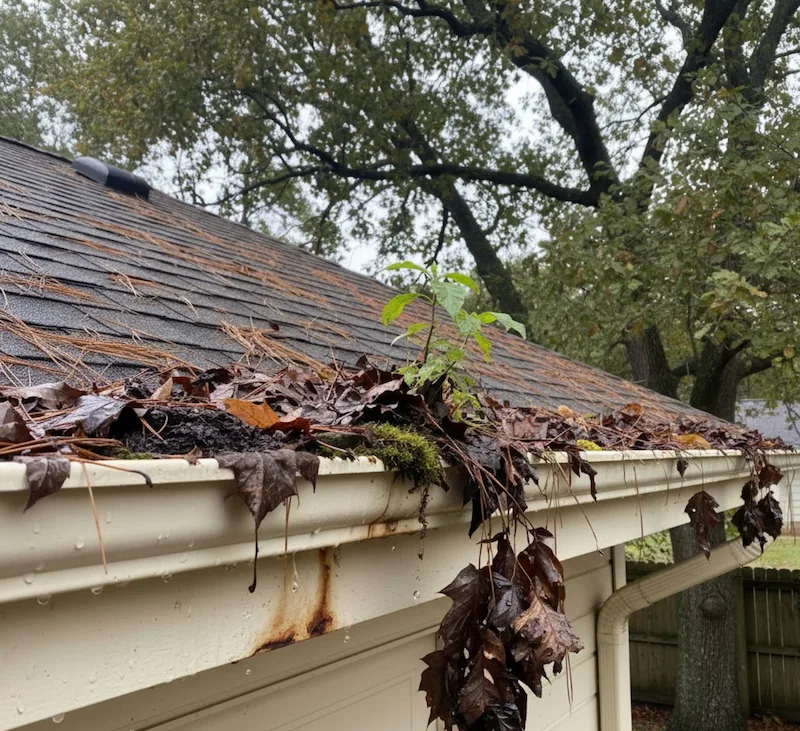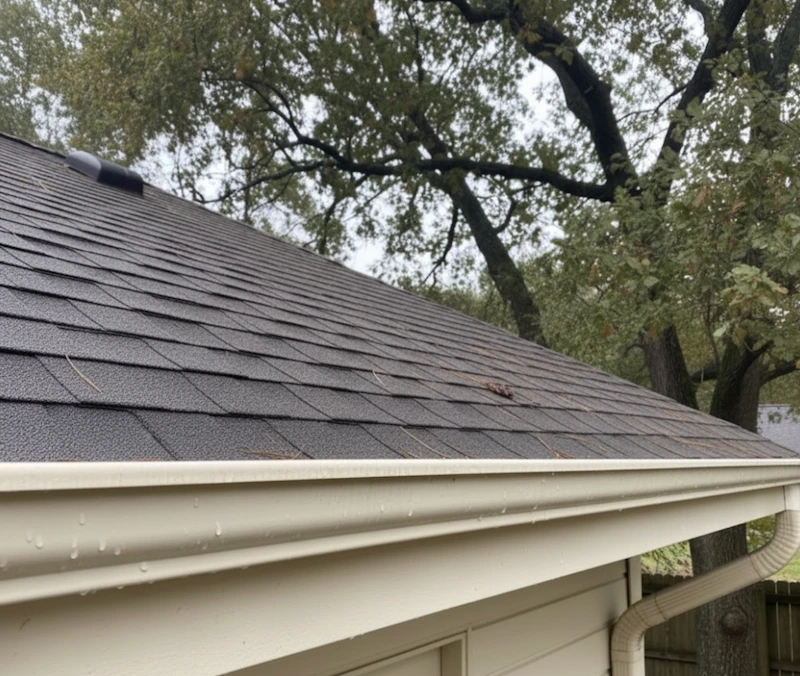The Vancouver Climate: Perfect for Moss (and Not for Roofs)

Vancouver’s mild, wet climate is paradise for moss and algae. With more than 1,167 mm of annual rainfall and months of overcast skies, moisture lingers long after each storm. Add in tree cover from cedar, fir, and maple canopies; and you have the ideal breeding ground for green growth. North- and east-facing roof slopes, shaded yards, and homes near forested lots (like those in North Vancouver or Burnaby Mountain) are especially prone.
To protect your home from this natural cycle, start with professional gutter cleaning in Vancouver designed for our coastal environment.
Why Moss and Algae Form on Roofs
It’s not just about rain, biology plays a part too.
Moss is a small plant that anchors to damp surfaces using rhizoids (BC Gov – Invasive Plants and Moss). Once established, it holds water against shingles or shakes, accelerating decay.
Algae, often seen as dark streaks, feeds on organic matter like pollen or debris (ARMA – Algae Discoloration on Roofs).
Lichen is a slow-growing mix of fungus and algae that bonds tightly to surfaces, often following years of buildup.
Together, they trap moisture, lift shingles, and block drainage. The result: leaks, premature wear, and in some cases, voided roof warranties, unless you use a soft-wash moss removal service that prevents damage.
Where It Grows Most in Vancouver
- North- and east-facing slopes that receive less sunlight.
- Homes surrounded by tall trees; especially in West Vancouver, Lynn Valley, and Coquitlam.
- Older cedar shakes and asphalt shingles, which retain moisture more than metal or composite materials.
- Multi-roofline homes, where runoff pools or gutters overflow.
Tree cover doesn’t just shade the roof; it adds debris and constant moisture. Regular professional gutter cleaning in Vancouver helps reduce these risks and keeps runoff moving freely.
The Real Risks of Roof Moss and Algae
Ignoring the green fuzz can lead to:
- Moisture damage and leaks from lifted or warped shingles.
- Shortened roof lifespan, often by 5–10 years if untreated.
- Blocked gutters and downspouts, causing overflow and fascia damage (see gutter cleaning services to prevent buildup).
- Compromised curb appeal, with dark stains and patchy growth visible from the street.
- Potential warranty issues, since many manufacturers require regular maintenance (and may void coverage for neglect) (James Hardie Care & Maintenance Guide).
How to Prevent Moss & Algae Growth
1. Manage Moisture and Shade
Trim back overhanging branches to let sunlight dry your roof after rain (BC Hydro Tree Trimming and Vegetation Management). Keep gutters clear so runoff doesn’t back up under shingles.
2. Clean Seasonally
Rinse debris with a low-pressure hose every few months, especially after fall leaf drop (Consumer Reports – Roof Cleaning Tips). A gentle clean prevents organic matter from feeding moss colonies.
3. Install Zinc or Copper Strips
When rainwater runs over these metals, trace ions naturally inhibit moss and algae growth (University of Minnesota Extension – Preventing Moss on Roofs). They’re a low-maintenance, long-term defense.
4. Schedule Professional Roof Cleaning
A soft-wash treatment removes moss and algae without the damage of high-pressure washing. Certified crews use biodegradable, non-corrosive detergents to protect roofing materials and landscaping. Learn more about soft wash cleaning in Vancouver.
5. Keep Surrounding Areas Maintained
Clean gutters, siding, and skylights regularly. Moss spores spread easily between exterior surfaces, stopping them at the source keeps your whole home cleaner longer. Our siding cleaning in Vancouver service helps prevent regrowth beyond the roofline.
Local Case Study: West Vancouver Cedar Shake Roof
After years of shade from mature evergreens, a homeowner in West Vancouver noticed moss spreading across the north-facing side of their cedar shake roof. A one-day soft-wash treatment removed the buildup, followed by zinc strip installation to prevent regrowth (WorkSafeBC – Falls from Elevation Guidelines). Twelve months later, the roof remains clear—proof that the right method can outlast the rain.
Explore our roof cleaning before and after results to see real transformations.


How to Prevent Moss & Algae Growth
1. Manage Moisture and Shade
Trim back overhanging branches to let sunlight dry your roof after rain (BC Hydro Tree Trimming and Vegetation Management). Keep gutters clear so runoff doesn’t back up under shingles.
2. Clean Seasonally
Manual removal of debris and moss every few months; especially after fall leaf drop (Consumer Reports – Roof Cleaning Tips). A gentle clean prevents organic matter from feeding moss colonies.
3. Install Zinc or Copper Strips
When rainwater runs over these metals, trace ions naturally inhibit moss and algae growth (University of Oregon Extension – Preventing Moss on Roofs). They’re a low-maintenance, long-term defence.
4. Schedule Professional Roof Cleaning
A soft-wash treatment removes moss and algae without the damage of high-pressure washing. Certified crews use biodegradable, non-corrosive detergents to protect roofing materials and landscaping. Learn more about soft-wash cleaning in Vancouver.
5. Keep Surrounding Areas Maintained
Clean gutters, siding, and skylights regularly. Moss spores spread easily between exterior surfaces; stopping them at the source keeps your whole home cleaner longer. Our siding cleaning in Vancouver service helps prevent regrowth beyond the roofline.
What to Do If Moss Has Already Taken Hold
Avoid scraping or high-pressure washing your shingles; NRCA guidance warns that improper maintenance techniques can damage roof systems. (NRCA – Roof Maintenance Tips).
Apply a gentle moss treatment, ideally on a dry day when no rain is expected for 24 hours.
Let dead moss naturally weather off, this prevents granule loss.
Schedule an annual professional inspection to catch regrowth early.
If moss covers large roof sections, professional cleaning is the safest choice. WashTech’s roof moss removal specialists use soft-wash systems designed for Vancouver’s climate and roofing materials, restoring surfaces without voiding warranties.
FAQs
How often should I clean my roof in Vancouver?
According to Canada Mortgage and Housing Corporation (CMHC), homeowners should follow a regular annual inspection and maintenance schedule to protect exterior materials. For Vancouver’s wet climate, this means cleaning once a year; ideally after spring pollen or before the autumn rains return, to keep moss and debris from taking hold.
Is pressure washing safe for roof moss removal?
No. High-pressure water can strip granules and shorten roof life. Always choose soft-wash methods.
Which roof materials resist moss best?
Metal and composite roofs shed water more efficiently and dry faster than cedar or asphalt.
When is the best time of year to clean a roof in Vancouver?
Late spring or early fall offers the best results. Surfaces are typically dry enough for treatment, and temperatures allow moss control products to work effectively before winter rain returns.
Do zinc or copper strips really prevent moss?
Yes. When rainwater runs over zinc or copper, trace metal ions wash down the roof surface and inhibit moss and algae growth. A source from the University of Oregon Extension confirms their long-term effectiveness; especially when installed along roof ridges.
Ready to Protect Your Roof?
Moss and algae might love Vancouver’s climate; but your roof doesn’t have to.
Book a professional cleaning with WashTech to restore your home’s curb appeal and extend its lifespan.
Request a Free Quote or Inspection
Also explore our related services:

.webp)